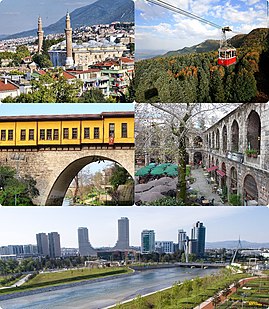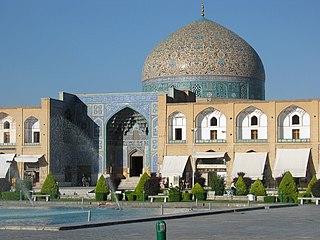
Bursa is a city in northwestern Turkey and the administrative center of the Bursa Province. The fourth most populous city in Turkey and second most populous in Marmara Region. Bursa is one of the industrial centers of the country. Most of the Turkey's automotive production takes place in Bursa.

A mosque is a place of worship for Muslims. Any act of worship that follows the Islamic rules of prayer can be said to create a mosque, whether or not it takes place in a special building. Informal and open-air places of worship are called musalla, while mosques used for communal prayer on Fridays are known as jāmiʿ. Mosque buildings typically contain an ornamental niche (mihrab) set into the wall that indicates the direction of Mecca (qiblah), ablution facilities and minarets from which calls to prayer are issued. The pulpit (minbar), from which the Friday (jumu'ah) sermon (khutba) is delivered, was in earlier times characteristic of the central city mosque, but has since become common in smaller mosques. Mosques typically have segregated spaces for men and women. This basic pattern of organization has assumed different forms depending on the region, period and denomination.

Hagia Sophia is the former Greek Orthodox Christian patriarchal cathedral, later an Ottoman imperial mosque and now a museum in Istanbul, Turkey. It is famous for its large dome. Built in AD 537, during the reign of Justinian, it was the world's largest building and an engineering marvel of its time. It is considered the epitome of Byzantine architecture and is said to have "changed the history of architecture".

Al-Aqsa Mosque, located in the Old City of Jerusalem, is the third holiest site in Islam. The mosque was built on top of the Temple Mount, known as the Al Aqsa Compound or Haram esh-Sharif in Islam. Muslims believe that Muhammad was transported from the Great Mosque of Mecca to al-Aqsa during the Night Journey. Islamic tradition holds that Muhammad led prayers towards this site until the 17th month after his migration from Mecca to Medina, when Allah directed him to turn towards the Kaaba in Mecca.

Babri Masjid was a mosque in Ayodhya, India at a site believed by Hindus to be the birthplace of Hindu deity Rama. It has been a focus of dispute between the Hindu and Muslim communities since the 18th century. According to the mosque's inscriptions, it was built in 1528–29 by general Mir Baqi, on orders of the Mughal emperor Babur. The mosque was attacked and demolished by Hindu Karsevaks in 1992 and ignited communal violence across the Indian subcontinent.

Minaret is a type of tower typically built into or adjacent to mosques. Minarets serve multiple purposes. While they provide a visual focal point, they are generally used for the Muslim call to prayer (adhan). The basic form of a minaret includes a base, shaft, a cap and head. They are generally a tall spire with a conical or onion-shaped crown.

Islamic architecture comprises the architectural styles of buildings associated with Islam. It encompasses both secular and religious styles from the early history of Islam to the present day. Early Islamic architecture was influenced by Roman, Byzantine, Persian, Mesopotamian architecture and all other lands which the Early Muslim conquests conquered in the seventh and eighth centuries. Further east, it was also influenced by Chinese and Mughal architecture as Islam spread to Southeast Asia. Later it developed distinct characteristics in the form of buildings, and the decoration of surfaces with Islamic calligraphy and geometric and interlace patterned ornament. New architectural elements like cylindrical minarets, the pointed arch, muqarnas, arabesque, multifoil were invented. The principal Islamic architectural types for large or public buildings are: the mosque, the tomb, the palace, and the fort. From these four types, the vocabulary of Islamic architecture is derived and used for other buildings such as public baths, fountains and domestic architecture.

Sultan Ahmed Mosque, also known as the Blue Mosque, is a historic mosque located in Istanbul, Turkey. It remains a functioning mosque, while also attracting large numbers of tourist visitors. It was constructed between 1609 and 1616 during the rule of Ahmed I. Its Külliye contains Ahmed's tomb, a madrasah and a hospice. Hand-painted blue tiles adorn the mosque’s interior walls, and at night the mosque is bathed in blue as lights frame the mosque’s five main domes, six minarets and eight secondary domes. It sits next to the Hagia Sophia, another popular tourist site.

Mihrab, (Persian: مهرابه, mihrāba), is a semicircular niche in the wall of a mosque that indicates the qibla, that is, the direction of the Kaaba in Mecca and hence the direction that Muslims should face when praying. The wall in which a mihrab appears is thus the "qibla wall".

Al-Masjid an-Nabawī is a mosque established and built by the Islamic prophet Muhammad, situated in the city of Medina in the Hejaz region of Saudi Arabia. It was one of the first mosques built by Muhammad, and is now one of the largest mosques in the world. It is the second-holiest site in Islam, after the Great Mosque in Mecca. It is always open, regardless of date or time.

The Süleymaniye Mosque is an Ottoman imperial mosque located on the Third Hill of Istanbul, Turkey. The mosque was commissioned by Suleiman the Magnificent and designed by the imperial architect Mimar Sinan. An inscription specifies the foundation date as 1550 and the inauguration date as 1557. The mosque was built by the Ottoman sultan Suleyman and the mosque was named after him. The mosque is located at the highest end of the city of Istanbul. It is designed to glorify the sultan. Construction of this mosque began before 1550 and was nearly completed in 1557. Sultan Suleyman used Mimar Sinan, the greatest engineer and architect of his time for the work of this mosque. The architecture and craftsmanship of the mosque are very beautiful and attract many worshipers and visitors.

The Masjid-i Jehan Numa, commonly known as the Jama Masjid of Delhi, is one of the largest mosques in India. It was built by the Mughal Emperor Shah Jahan between 1650 and 1656 at a cost of one million rupees, and was inaugurated by Imam Syed Abdul Ghafoor Shah Bukhari from Bukhara, present-day Uzbekistan. The mosque was completed in 1656 AD with three great gates and two 40 metres high minarets constructed with strips of red sandstone and white marble. The courtyard can accommodate more than 25000 people. There are three domes on the terrace which are surrounded by the two minarets. On the floor, a total of 899 black borders are marked for worshippers. The architectural plan of Badshahi Masjid, built by Shah Jahan's son Aurangzeb at Lahore, Pakistan, is similar to the Jama Masjid. The Majestic Mosque for Indian Muslims is considered as the "National Mosque of India" respectively.

Mughal architecture is the type of Indo-Islamic architecture developed by the Mughals in the 16th, 17th and 18th centuries throughout the ever-changing extent of their empire in the Indian subcontinent. It developed the styles of earlier Muslim dynasties in India as an amalgam of Islamic, Persian, Turkic and Indian architecture. Mughal buildings have a uniform pattern of structure and character, including large bulbous domes, slender minarets at the corners, massive halls, large vaulted gateways, and delicate ornamentation; "grandiose architecture was the most visible of the ways that the Mughals used to assert their sense of superiority and their supremacy over what in many ways remained to them an alien land". Examples of the style can be found in modern-day India, Afghanistan, Bangladesh, and Pakistan.

Ottoman architecture is the architecture of the Ottoman Empire which emerged in Bursa and Edirne in 14th and 15th centuries. The architecture of the empire developed from the earlier Seljuk architecture and was influenced by the Byzantine architecture, Iranian as well as Islamic Mamluk traditions after the conquest of Constantinople by the Ottomans. For almost 400 years Byzantine architectural artifacts such as the church of Hagia Sophia served as models for many of the Ottoman mosques. Overall, Ottoman architecture has been described as Byzantine influenced architecture synthesized with architectural traditions of Central Asia and the Middle East.

The Grand Mosque seizure occurred during November and December 1979 when armed civilians calling for the overthrow of the House of Saud took over Masjid al-Haram in Mecca, Saudi Arabia. The insurgents declared that the Mahdi had arrived in the form of one of their leaders, Mohammed Abdullah al-Qahtani, and called on Muslims to obey him. For nearly two weeks Saudi Special Forces, advised by three GIGN French commandos, fought battles to reclaim the compound.
A jama masjid, also known as a congregational mosque or Friday mosque, is a type of mosque which is the main mosque of a certain area that hosts the special Friday noon prayers known as jumu'ah. They also host the Eid prayers in situations when there is no musalla or eidgah available or nearby to host the prayers.

The Badshahi Mosque is a Mughal era mosque in Lahore, capital of the Pakistani province of Punjab, Pakistan. The mosque is located west of Lahore Fort along the outskirts of the Walled City of Lahore, and is widely considered to be one of Lahore's most iconic landmarks.

The Great Mosque of Mecca, commonly known as al-Masjid al-Ḥarām, is a mosque that surrounds the Kaaba in the city of Mecca, in the Hejazi region of Saudi Arabia. It is a site of pilgrimage for the Hajj, which every Muslim must do at least once in their lives if able, and is also the main phase for the ʿUmrah, the lesser pilgrimage that can be undertaken any time of the year. The rites of both pilgrimages include circumambulating the Kaaba within the mosque. The Great Mosque includes other important significant sites, including the Black Stone, the Zamzam Well, Maqam Ibrahim, and the hills of Safa and Marwa.

Two consecutive mass shootings occurred at mosques in a terrorist attack in Christchurch, New Zealand, during Friday Prayer on 15 March 2019. The attack, carried out by a single gunman who entered both mosques, began at the Al Noor Mosque in the suburb of Riccarton at 1:40 p.m. and continued at Linwood Islamic Centre at 1:52 p.m. He killed 51 people and injured 49.

The Sidi Darghut Mosque or Jama Sidi Darghut is a mosque in Tripoli, Libya. It was built in around 1560 by Dragut on the site of a Hospitaller church, parts of which were incorporated into the mosque. The mosque was damaged in World War II but it was subsequently repaired, although the reconstruction was not completely faithful to its original design.



















